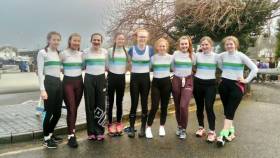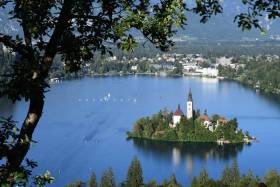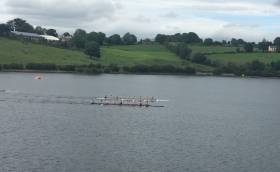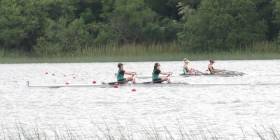Displaying items by tag: Neptune
Commercial and Shandon Shine in the Sun at Metro Regatta
Rowing: Commercial won the Division One coxed and coxless fours and the Division One pairs (through intermediates Charlie Cunningham and Lorcain Cameron), while 17-year-old Jack Dorney took the men’s Division One single sculls at the refixed Metro regatta at Blessington today.
The day could hardly have been better for rowing, but the entry was thin because of clashes with exams and other events. Young competitors shone: the women’s Division One pair A Final was made up entirely of junior 18 crews, with Castleconnell the clear winners; the New Ross’s junior 18 crew of Shona Tierney and Lara Brown were the top women’s double scull and Tristan Orlic of Neptune, who is 16, won Division Two of the men’s single single sculls.
Metropolitan Regatta, Blessington, Saturday
Men
Eight – Div Two: Neptune (club two) 5:40.496.
Four – Div One: Commercial A (sen) 5:36.26. Four, coxed – Div One: 1 Commercial (sen) 5:55.01, 2 Shandon (jun 18A) 5:55.99, 3 Commercial (inter) 5:56.41; 5 UCD (club one) 6:02.82.
Pair – Div One: Commercial (inter) 6:07.65, 2 Commercial (sen) 6:14.6. B Final: 2 Castleconnell 6:25.78; 4 Belfast RC (club one) 6:43.92.
Sculling, Single – Div One: Shandon (J Dorney; jun 18A) 6:34.78, 2 St Michael’s (D O’Connor; sen) 6:37.81. B Final: Three Castles (T McKnight; inter) 6:47.52; 5 Commercial (J Casey; club one) 7:11.88. Div Two: Neptune (T Orlic; jun 16) 6:47. 76, 2 Clonmel (O’Donnell; club two) 6:49.48, 3 St Michael’s (O’Gorman; jun 18B) 7:00.84
Women
Four, coxed – Div Two: Neptune (club two) 6:56.77.
Sculling, Quadruple – Div Two, coxed: Commercial (jun 16) 6:51.87, 2 Neptune (club two) 6:54.06, 3 Fermoy (nov) 6:54.57; 6 Commercial (jun 18B) 7:49.09.
Double – Div One: New Ross (jun 18A) 6:43.13; 3 Neptune (club one) 6:48.66; 4 St Michael’s (sen) 7:05.97. Div Two: Carlow (jun 16) 7:11.58, 2 Neptune (club two) 7:36.47.
Single – Div One: 1 Castleconnell (jun 18) 7:14.24.
Irish Crews Amongst the Trophies Again at London Met
#Rowing: Philp Doyle of Queen’s and Ronan Byrne of UCC won the Championship Double and Sam McKeown of Queen’s the Championship Single on the second day of London Metropolitan Regatta at Dorney Lake today. Doyle and Byrne form part of the Ireland training group at the National Rowing Centre. Tristan Orlic of Neptune also took the junior 18 singles at Dorney. Commercial competed in the Challenge Eight and won a trophy.
London Metropolitan Regatta, Dorney Lake (Irish interest; selected results, winners unless stated)
Saturday
Men
Eight – Championship: 1 Leander 5:49.90, 2 Commercial 5:52.74.
Four – Championship: 3 Commercial 6:12.20. Tier Two: Shandon.
Four, coxed – Tier Three: Tribesmen 6:32.26. Academic, Tier Two: NUIG.
Pair – Tier Two: UCC 7:14.93.
Double Sculls – Championship: 2 UCC (R Byrne, H Sutton) 6:32.50. Tier Two: Castleconnell 6:42.50.
Single Sculls – Championship: 2 UCC (R Byrne) 7:03.99. Tier Two: Univ of Limerick (K Mannix) 7:18.36. Tier Three: St Michael’s (D O’Connor).
Women
Eight – Club, Tier Two: NUIG/Tribesmen 6:50.64. Academic, Tier Two: Trinity 6:57.77.
Four – Academic, Tier Two: Trinity 7:08.62.
Four, coxed – Championship: NUIG/Tribesmen 7:20.88. Tier Four: Univ of Limerick.
Pair – Championship: 2 Commercial (H O’Neill, R Morris) 7:46.57. Tier Two: NUIG 7:39.84.
Double Sculls – Championship: 3 London/Skibbereen (M Jackson, N Long) 7:28.48.
Sunday
Men
Four – Tier Four: UCC 6:47.80. Four, coxed – Tier Two: UCC 6:55.08.
Double – Championship: UCC/Queen’s (R Byrne, P Doyle) 6:28.43. Tier Two: UCC/Queen’s (Byrne, Doyle) 6:37.50.
Single – Championship: Queen’s (S McKeown) 7:11.67. Tier Three: Castleconnell (S Haugh) 7:29.95. Jun 18: Neptune (T Orlic) 7:53.76.
Women
Four, coxed – Tier Two: NUIG/Tribesmen 7:45.07. Tier Three: Univ of Limerick 7:49.44.
Pair – Tier Two: Cork 7:22.18.
#Rowing: Portadown Regatta enjoyed almost perfect conditions today. A packed programme was run in bright, warm sunshine and on flat water. RBAI beat the host club in one of the top events of the day, the men’s junior 18 eights final, reversing the decision of last year.
Shauna Murtagh of Carrick-on-Shannon beat Kate Crawford of Portadown in the women’s junior 18 single sculls – a first win in a regatta for the 16-year-old daughter of Ireland great Frances Cryan.
The men’s junior 18 single was won by Hugh Moore of Coleraine Grammar School.
#Rowing: Trinity won the men’s senior eight at Commercial Regatta at Islandbridge today. Commercial had divided their Championships winning eight into two crews. The rain came – at almost exactly the same time as in Saturday’s Neptune Regatta, but the full set of races were held. Neptune beat Commercial in the women’s club one eight, one of the last of a long day.
Commercial Regatta, Islandbridge, Sunday (Selected Results)
Men,
Eight – Senior: Trinity bt Commercial, 2l. Club One: UCD bt Commercial 1l. Novice: UCD B bt Trinity A 1l. Jun 18A: Neptune beat Coláiste Iognáid 1l. Jun 15: Athlone bt Coleraine GS 4l.
Four – Inter, coxed: Trinity bt Commercial 2l. Club One, coxed: Commercial B bt Neptune, canvas. Jun 18A: Col Iognaid bt New Ross 3l.
Sculling, Quadruple – Club One, coxed: Neptune bt Commercial, scratched. Novice: Commercial bt Neptune 1l. Jun 18A, coxed: Col Iognaid bt Blackrock ½ l. Jun 16, coxed: Blackrock A bt Coleraine GS 1 ½ l.
Double – Senior: Commercial/Neptune bt Neptune ½ l. Club One: King’s Hospital bt Neptune distance. Jun 18A: Neptune C bt Three Cstles B 2l. Jun 16: Blackrock bt Carlow B 3l.
Single – Inter: Sligo (G Patterson) bt Offaly (C Brady) 3l. Club One: Lagan (N Darby) bt Carrick-on-Shannon (E Djeribi) 5l. Jun 18: Carrick (F Early) bt Neptune (S Byrne) 1l.
Women
Eight – Inter: Commercial bt Trinity 3l. Club One: Neptune bt Commercial 1 ½ l. Nov: UCD A bt UCD B distance. Jun 18A: Col Iognaid bt Commercial 3l. Jun 16: Coleraine Grammar School bt Commercial 1 ½ l.
Four – Senior, coxed: Commercial A bt Commercial B 1l. Inter: Commercial B bt Commercial A, distance. Club One, coxed: UCD D bt UCD B 3l. Jun 18A, coxed: Col Iognaid bt Commercial ½ l.
Sculling, Quadruple – Club One, coxed: Neptune A bt Athlone ¾ l. Nov, coxed: Neptune bt Trinity 2l. Jun 18, coxed: Col Iognaid bt Sligo 4l. Jun 16, coxed: Commercial bt Neptune 2l.
Double – Club One: King’s Hos A bt King’s Hos B, 3l. Jun 18A: Commercial A bt Carrick-on-Shannon 3l. Jun 16: Commercial bt Athlone A 3l.
Enniskillen and Coláiste Iognáid Pick up Pennants at Carrick
#Rowing: The Head of the Shannon enjoyed good weather and an appreciative crowd at Carrick-on-Shannon on Saturday. The timing system encountered some difficulties. Neptune’s junior 18 quadruple were the fastest crew in the first head. The pennant for this class was granted in the second head and Enniskillen took it. The Fermanagh club had a set of wins at junior level, as did Coláiste Iognáid of Galway. Commercial’s junior 16 women’s eight also came out on top.
Head of the Shannon, Carrick-on-Shannon, Selected Results (Category winners)
Head One
Men
Eight – Jun 16: Col Iognáid. Masters: Neptune (d)
Four – Jun 18, coxed: Enniskillen
Pair – Sen: Galway. Jun 18: Enniskillen
Sculling
Quadruple – Jun 16, coxed: Sligo. Masters: Galway (e). Masters, coxed: Athlone (e).
Double – Sen: Portadown. Masters: City of Derry (d). Jun 18: Enniskillen
Single – Jun 16: Athlone (Carroll)
Women
Eight – Jun 18: Col Iognáid
Four – Club, coxed: Athlone
Sculling, Quadruple – Jun 18: Enniskillen
Double – Club: Carrick-on-Shannon. Jun 16: Commercial
Single – Club: Carrick-on-Shannon (Early). Jun 18: Enniskillen (Fee)
Head Two
Men
Eight, Jun 18: Portadown
Four – Masters, coxed: Athlone (b)
Sculling
Quadruple – Jun 18: Enniskillen
Double – Club: Enniskillen. Jun 16: Enniskillen
Single – Sen: Sligo (G Patterson). Jun 18: Carrick-on-Shannon (Early). Masters: Athlone (Gallen, f)
Women,
Eight
Club: Galway. Jun 16: Commercial. Masters: Tribesmen B (e)
Four – Jun 18: Col Iognáid.
Pair – Jun 18: Col Iognáid
Sculling
Quadruple – Jun 16, coxed: Sligo.
Double – Jun 18: Enniskillen
Single – Club: Carrick-on-Shannon (T Duggan). Jun 16: Carrick-on-Shannon (Murtagh).
Four and Pair add to Irish Tally at World Masters
#Rowing: The C coxed four of Rob Forde, Patrick Fowler, Oisin McGrath, Gary O’Neill and Tony Corcoran won their heat. The Commercial, Clonmel and Neptune crew beat a Monmouth crew from Britain by almost two seconds.
Milo and Patrick Murray from Cappoquin brought Ireland’s win tally on the day to three when they won in the F Pair.
Earlier an Irish composite eight had won in the E class.
World Masters Regatta, Bled, Slovenia, Day Four (Selected Results; Irish interest; all heats of 1,000 metres, winners only)
Men
Eight ‘E’ (Avg 55 or more) – Heat Three: Waterford, Neptune, Commercial, Belfast BC (A Penkert, J Hudson, D Crowley, G Murphy, M Heavey, C Dickson, C Hunter, F O’Toole, D McGuinness) 3:07.88.
Four, coxed ‘C’ (Avg 43 or more) – Heat Four: Commercial, Clonmel, Neptune (T Corcoran, R Forde, P Fowler, O McGrath, G O’Neill) 3:19.51.
Pair ‘F’ (Avg 60 or more) – Heat Five: Cappoquin (P Murray, M Murray) 3:46.64.
Sweet Win For Irish Composite Eight at World Masters
#Rowing: One of the leading Irish boats at the World Masters Regatta in Bled in Slovenia clocked up a notable win today. The E eight made up of competitors from Belfast Boat Club, Commercial, Neptune and Waterford beat Dynamo of Russia, who have been their constant rivals of recent years. The margin was extremely tight – just .26 of a second.
World Masters Regatta, Bled, Slovenia, Day Four
Men
Eight ‘E’ (Avg 55 or more) – Heat Three: Waterford, Neptune, Commercial, Belfast BC (A Penkert, J Hudson, D Crowley, G Murphy, M Heavey, C Dickson, C Hunter, F O’Toole, D McGuinness) 3:07.88.
Irish Crews Win at World Masters Regatta
#Rowing: Irish composite crews had good wins on the first day of the World Masters Regatta in Bled in Slovenia. The Irish B eight (average age 36 or more), which is formed from six clubs won. Two fours in the E class (average age 55 or more) also won – the Galway/Neptune combination by just .26 of a second. The decision was initially given to their German opponents.
World Masters Regatta, Bled, Slovenia, Day One (Selected Results; Irish interest; all heats of 1,000 metres, winners only)
Men
Eight, B (avg 36 or more) – Heat Five: Galway, Commercial, Shandon, Clonmel, Neptune, Cork 3:05.51.
Four, E (avg 55 or more) – Heat One: Galway, Neptune 3:26.26.
Heat Four: Waterford, Neptune, Commercial, Belfast BC 3:28.1
UCC/Skibbereen Women's Eight Win on the Line at Cork Regatta
#Rowing: The Skibbereen/UCC composite won the women’s eights with the final few strokes at the Cork Grand League Regatta today. NUIG led them coming up to the line, but the winners finished faster to win by three tenths of a second. Cork were the best junior 18 eight.
UCD won the men’s eights by holding off NUIG. The finish was close, but UCD had led down the course and refused to yield. Neptune took the junior 18 honours by holding off St Joseph’s of Galway in the B Final.
Cork Regatta, National Rowing Centre, Cork, Day Two (Selected Results)
Men
Eight – Division One – A Final: 1 UCD (N Farrell, R Thompson, E O’Connor, C O’Riada, E Gleeson, A Griffin, T Doherty, M Murphy; cox: O Reid; senior) 5:51.05, 2 NUIG (sen) 5:51.91, 3 UCD (inter) 6:05.098; 4 Cork (club one) 6:05.46. B Final: 4 Neptune (Jun 18A) 6:13.69.
Four – Div One – A Final: 1 NUIG (sen) 6:16.41. Four, coxed – Div Two – A Final: 1 Queen’s B (club two) 6:53.69, 2 St Michael’s (jun 18B) 6:56.53; 6 Presentation, Cork (jun 16) 7:33.61.
Sculling,
Quadruple, Div Two, coxed – A Final: 1 Carlow (jun 18B) 6:43.70; 3 Castleconnell (jun 16) 6:53.53; 4 Shandon (club two) 6:54.67.
Double – A Final: 1 Skibbereen (G O’Donovan, P O’Donovan; sen) 6:25.51, 2 Commercial, UCD (N Beggan, A Goff; sen) 6:27.62, 3 Skibbereen (M O’Donovan, S O’Driscoll; sen) 6:37.997; 5 Three Castles A (jun 18A) 6:49.76. B Final: St Michael’s (inter) 6:51.20.
Single – Div Two – A Final: 1 Three Castles (A Keogh; jun 16) 7:29.64, 2 Cappoquin (S Landers; club two) 7:35.39; 6 Killorglin (J McCarthy; Jun 18B) 7:52.86.
Women
Eight – Div One – A Final: 1 Skibbereen/UCC (O Hayes, F O’Keeffe, A Casey, E McCarthy A Keogh, E Hegarty, N Casey, D Walsh; cox C O’Connell; senior) 6:37.94, 2 NUIG (sen) 6:38.30; 5 NUIG (club one) 6:58.38. B Final: 1 Cork (jun 18A) 7:00.93; 2 Shandon (inter) 7:02.79.
Four – Div One – A Final: 1 Skibbereen, UCC (N Casey, E Hegarty, A Keogh, D Walsh; sen) 6:59.0. B Final: Col Iognaid (jun 18A) 7:39.68. Div Two, coxed – A Final: Trinity (club two) 7:41.79.
Sculling, Double – Div One – A Final: 1 Cork (inter) 7:19.591, 2 Lee (jun 18A) 7:23.45. B Final: 2 Carlow (club one) 7:40.31. Div Two – A Final: 1 Neptune (J Poh; club two) 8:40.47, 2 Kenmare (E Crowley; jun 18B) 8:42.76; 3 Neptune (N Clarke; jun 16) 8:46.62.
Feerick and Clarke Win With Fine Finish
#Rowing: Claire Feerick and Ava Clarke beat a Carlow-Kenmare composite in a tight finish of the women’s senior double at Lough Rynn Regatta today. The men’s four was also a tight race with NUIG beating a junior four which may represent Ireland at the Coupe de la Jeunesse.
Lisa Dilleen of Cork Boat Club won the women’s senior single sculls and Hannah Scott won the women’s junior 18 single. A re-row was called for the first two crews in the the men’s junior single. A launch stalled in the lane of Aaron Christie of Bann, who was in contention for first.
Tailwind conditions strengthened in late morning at the venue, but rowing continued on the impressive course.
Lough Rynn Regatta, Leitrim (Selected Results)
Men
Eight – Jun 15: Col Iognaid. Masters: Athlone (f).
Four – Senior: 1 NUIG, 2 Enniskillen, Cork. Inter, coxed: 1 NUIG A, 2 Commercial, 3 Skibbereen. Club, coxed: 1 NUIG A, 2 NUIG B, 3 Enniskillen.
Pair – Jun 18: 1 Commercial B, 2 Commercial A, 3 Commercial C.
Sculling, Quadruple – Jun 16, coxed: 1 Castleconnell.
Sculling, Quadruple – Club, coxed: 1 Carlow, 2 Enniskillen, 3 Col Iognaid.
Double – Jun 16: Three Castles.
Single – Intermediate: 1 Skibbereen (Mannix), 2 Carlow (Murphy), 3 Shandon (O’Sullivan).
Women
Eight – Jun 16: St Michael’s. Masters: Belfast BC (e). Jun 15: Enniskillen A.
Four – Sen: 1 Cork, 2 Commercial, 3 NUIG. Inter, Club, Jun 16, coxed: NUIG (inter).
Sculling, Quadruple – Nov, coxed: 1 Neptune, 2 Galway, 3 King’s Hospital. Club, coxed: 1 Methodist, 2 King’s Hos, 3 Commercial. Jun 18: 1 Clonmel, 2 Belfast BC, Portadown, Bann (sen). 3 Comercial.
Double – Sen: 1 Neptune, 2 Carlow/Kenmare, 3 Garda/NUIG. Club: 1 Bann, 2 St Michael’s, 3 Carlow. Jun: 1 Castleconnell, 2 Commercial, 3 Portadown. Masters: Tribesmen A (d).
Single – Sen: 1 Cork (L Dilleen), 2 Skibbereen (L Heaphy), 3 Queen’s (O Blundell). Inter: 1 Bann (A O’Donovan), 2 Neptune (C Feerick), 3 Skibberee (L Heaphy). Jun 18: 1 Bann (H Scott), 2 Carlow (C Nolan), 3 Col Iognaid (Nic Dhonncha).




































































